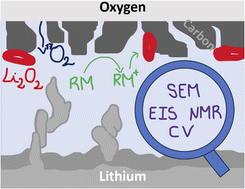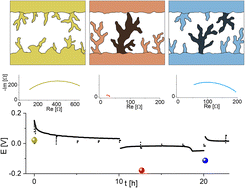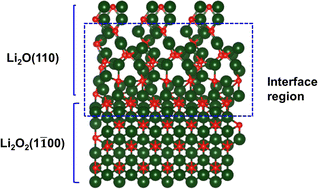Themed collection Rechargeable non-aqueous metal-oxygen batteries

List of participants
Faraday Discuss., 2024,248, 425-426
https://doi.org/10.1039/D3FD90067C
Poster list
Faraday Discuss., 2024,248, 423-424
https://doi.org/10.1039/D3FD90068A
Concluding remarks: a summary of the Faraday Discussion on rechargeable non-aqueous metal–oxygen batteries
The Faraday Discussion on rechargeable non-aqueous metal–oxygen batteries is summarised.

Faraday Discuss., 2024,248, 412-422
https://doi.org/10.1039/D3FD00170A
Spiers Memorial Lecture: Lithium air batteries – tracking function and failure
Here, we discuss experimental approaches developed by some of the authors to understand the function and failure of lithium–oxygen batteries.

Faraday Discuss., 2024,248, 9-28
https://doi.org/10.1039/D3FD00154G
Unraveling the solvent stability on the cathode surface of Li–O2 batteries by using in situ vibrational spectroscopies
The stability of a series of glyme solvents with different chain lengths during ORR/OER has been investigated using in situ vibrational spectroscopy measurements.

Faraday Discuss., 2024,248, 119-133
https://doi.org/10.1039/D3FD00092C
Dissolved LiO2 or adsorbed LiO2? The reactive superoxide during discharging process in lithium–oxygen batteries
We study the competition between the solution route and surface route during the discharging process in Li–O2 cells.

Faraday Discuss., 2024,248, 160-174
https://doi.org/10.1039/D3FD00080J
Solvent-dependent iodide interactions in LiO2 electrolytes – a molecular dynamics study
We explore the role of electrolyte composition in the solvation of I−, which has been shown to be critical for the efficient operation of this redox mediator, using a molecular dynamics approach.

Faraday Discuss., 2024,248, 145-159
https://doi.org/10.1039/D3FD00090G
Template assisted lithium superoxide growth for lithium–oxygen batteries
A simple goodness of fit R factor to gauge how well a template surface structure can support LiO2 growth is developed. The R factor may be extended to other transition and main group element LiMx catalysts, as potential LiO2 growth supports.

Faraday Discuss., 2024,248, 48-59
https://doi.org/10.1039/D3FD00116D
Evaluation of performance metrics for high energy density rechargeable lithium–oxygen batteries
The ratio of electrolyte amount against areal capacity (E/C) has a large impact on the performance of stacked-type lithium–oxygen batteries. The unique cell degradation behavior during the charging process under low E/C conditions was also demonstrated.

Faraday Discuss., 2024,248, 341-354
https://doi.org/10.1039/D3FD00082F
Toward solid-state Limetal–air batteries; an SOFC perspective of solid 3D architectures, heterogeneous interfaces, and oxygen exchange kinetics
Solid-state Li–O2 battery, 3D architecture and cycling performance.

Faraday Discuss., 2024,248, 266-276
https://doi.org/10.1039/D3FD00119A
Engineering considerations for practical lithium–air electrolytes
We consider the requirements to be placed on an electrolyte for it be used in a practical lithium–air battery. Ways to ease these requirements by refining cell design and improving transport as well as motifs for future electrolytes are discussed.

Faraday Discuss., 2024,248, 355-380
https://doi.org/10.1039/D3FD00091E
A lithium–air battery and gas handling system demonstrator
A Li–air battery is described with in-line gas handling that allows control over the flow and composition of the gas supplied to the cell, allowing simultaneous evaluation of the cell and scrubber performance.

Faraday Discuss., 2024,248, 381-391
https://doi.org/10.1039/D3FD00137G
Feasibility of achieving two-electron K–O2 batteries
A low-barrier, two-step reaction pathway for peroxide-based K–O chemistry is first realized without any catalysts under the inert argon atmosphere.

Faraday Discuss., 2024,248, 60-74
https://doi.org/10.1039/D3FD00085K
Effect of alkali-metal cation on oxygen adsorption at Pt single-crystal electrodes in non-aqueous electrolytes
The effect of Group 1 alkali-metal cations (Na+, K+, and Cs+) on the oxygen reduction and evolution reactions (ORR and OER) using dimethyl sulfoxide (DMSO)-based electrolytes was investigated.

Faraday Discuss., 2024,248, 102-118
https://doi.org/10.1039/D3FD00084B
Self-sufficient metal–air battery systems enabled by solid-ion conductive interphases
Rechargeable metal–air batteries operated in ambient air fail as a result of complex anode surface reactions. Interphases composed of metallic In protect Li anodes, enabling Li–air batteries to operate in ambient air.

Faraday Discuss., 2024,248, 305-317
https://doi.org/10.1039/D3FD00112A
The accumulation of Li2CO3 in a Li–O2 battery with dual mediators
We examine the build-up and distribution of Li2CO3 within the porous gas diffusion electrode during cycling and its link to cell failure.

Faraday Discuss., 2024,248, 318-326
https://doi.org/10.1039/D3FD00105A
A facile coprecipitation approach for synthesizing LaNi0.5Co0.5O3 as the cathode for a molten-salt lithium–oxygen battery
The reaction pathway for Li2O generation on the surface of perovskite LaNi0.5Co0.5O3 for a molten-salt lithium–oxygen battery operating at 160 °C is presented.

Faraday Discuss., 2024,248, 327-340
https://doi.org/10.1039/D3FD00078H
Insights into soft short circuit-based degradation of lithium metal batteries
A considerable performance gap between Li symmetric cells and practical Li batteries motivated us to explore the correlation between the shape of voltage traces and degradation.

Faraday Discuss., 2024,248, 277-297
https://doi.org/10.1039/D3FD00101F
A solid-state Li–air battery: computational studies of interfaces and relevance to discharge mechanism
Calculated interface between Li2O and Li2O2 surfaces showing the extent of disorder at the interface. Such interfaces are probably present in the new solid-state Li–air battery described here and contribute to the discharge and charge mechanisms.

Faraday Discuss., 2024,248, 134-144
https://doi.org/10.1039/D3FD00083D
Effect of depth of discharge (DOD) on cycling in situ formed Li anodes
This study demonstrates that the stability of cycling in situ Li anodes depends on their depth of discharge (DOD). High DOD cycling results in unstable performance due to the accumulation of interfacial degradation at Li/LLZO interfaces.

Faraday Discuss., 2024,248, 250-265
https://doi.org/10.1039/D3FD00079F
Bio-based ether solvent and ionic liquid electrolyte for sustainable sodium–air batteries
A green, low-toxic diglyme isomer, 1,2,3-trimethoxypropane, has been studied, for the first time, as the electrolyte in sodium–air batteries reaching 2.31 mA h cm−2 discharge capacity and with NaO2 as the main discharge product.

Faraday Discuss., 2024,248, 29-47
https://doi.org/10.1039/D3FD00096F
Singlet oxygen formation in non-aqueous oxygen redox chemistry: direct spectroscopic evidence for formation pathways and reliability of chemical probes
We have shown direct spectroscopic evidence of the previously identified pathways for singlet oxygen (1O2) formation in non-aqueous oxygen redox chemistry.

Faraday Discuss., 2024,248, 175-189
https://doi.org/10.1039/D3FD00088E
Operando detection and suppression of spurious singlet oxygen in Li–O2 batteries
We have operando detected the formation of singlet oxygen in a real Li–O2 battery by DMA fluorescence decay and its suppression by using physical quenchers, reaching an extended battery cycle life due to mitigation of spurious reactions

Faraday Discuss., 2024,248, 190-209
https://doi.org/10.1039/D3FD00081H
K–O2 electrochemistry at the Au/DMSO interface probed by in situ spectroscopy and theoretical calculations
This work identifies the key products and intermediates (O2−, KO2 and K2O2) and reveals their dependency on the electrode potential by combining in situ Raman spectroelectrochemistry and density functional theory calculations.

Faraday Discuss., 2024,248, 89-101
https://doi.org/10.1039/D3FD00071K
Mechanism of ORR and OER in non-aqueous electrolytes: general discussion
Faraday Discuss., 2024,248, 210-249
https://doi.org/10.1039/D3FD90060F
Towards practical metal–oxygen batteries: general discussion
Faraday Discuss., 2024,248, 392-411
https://doi.org/10.1039/D3FD90062B
Materials for stable metal–oxygen battery cathodes: general discussion
Faraday Discuss., 2024,248, 75-88
https://doi.org/10.1039/D3FD90059B
Metal anodes and protected interfaces: general discussion
Faraday Discuss., 2024,248, 298-304
https://doi.org/10.1039/D3FD90061D
About this collection
We are delighted to share with you a selection of the papers associated with a Faraday Discussion on Rechargeable non-aqueous metal-oxygen batteries. More information about the related event may be found here: http://rsc.li/batteries-fd2023. Additional articles will be added to the collection as they are published. The final versions of all the articles presented and a record of the discussions will be published after the event.
Metal–oxygen batteries have the potential to exceed the stored energy of today’s most advanced lithium-ion cells. However, their recharge and cyclability efficiency pose a major challenge to bringing this technology into practical application, as does improving our fundamental understanding of the electrochemistry and chemistry inside the cell. Li–O2 and Na–O2 are the most reported types of metal–oxygen cells but there has also been much recent work on K, Ca and Mg–O2 systems in non-aqueous electrolytes, which present different challenges and opportunities in terms of the stability and safety of the metal electrode. A critical examination of the state-of-play of metal–oxygen batteries is required to identify the major obstacles that remain in developing practical systems. This meeting will cover 4 main themes: Mechanism of ORR and OER in non-aqueous electrolytes, Materials for stable metal–oxygen battery cathodes, Metal anodes and Towards practical metal–oxygen batteries.
On behalf of the Scientific Committee, we hope you join us and participate in this exciting event, and that you enjoy these articles and the record of the discussion.